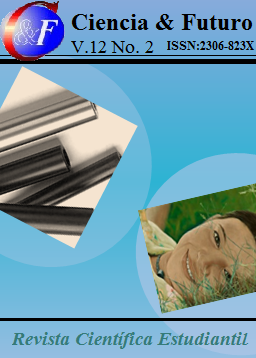Tensile strength of steel ASTM A 36 with edge preparation at different angles
Keywords:
traction, ASTM A 36, welding, bevel, thermal cycling.Abstract
The microconstituents in a butt welded ASTM A 36 steel with edge preparation by means of electric arc welding with electrode E 7018 were quantified through digital image processing. Samples with bevels of 30 and 35o were prepared, which were called MI for the former and MII for the latter. The phases, the grain boundaries and the area present in the microstructure of this steel visualized in an element called pixel were identified. It was determined that, in the molten zone and in the zone affected by heat for the 30o bevel, the phase that predominates is pearlitic with 82.25%, which occupies the greatest distribution over the area of the matrix and in that of 35th, there is a tendency to remain the same, but with 56.82%; which is associated with the heat input due to the effect of the thermal cycle and the type of angle used.Downloads
References
ADAK, D.; MUKHERJEE, M. & PAL, T. 2015. Development of a direct correlation of bead geometry, grain size and HAZ width with the GMAW process parameters on bead-on-plate welds of mild steel. India: Springer India 68(9): 839-849.
ASKELAND, D. & WRIGHT, W. 2016. Ciencia e Ingeniería de materiales. Séptima Edición, Cengage Learning Editores, Ciudad de México, México.
BOLAÑOSA, F.; CAICEDO, J.; ALFONZO, C.; SANTELIZ, A. & PORRELLO, A. 2018. Evaluación del comportamiento mecánico de un acero AISI 1045 sometido a tratamientos térmicos. Revista Ingeniería UC 25(1): 99-107.
CAREGLIO, C.; MONGE, D.; PACINI, E.; MATEOS, C.; MIRASSO, A. & GARINO, C. 2010. Sensibilidad de resultados del ensayo de tracción simple frente a diferentes tamaños y tipos de imperfecciones. Mecánica Computacional 29(41): 4181-4197.
CASTILLO, D.; ANGARITA, I. & RODRÍGUEZ, R. 2018. Caracterización microestructural y mecánica de aceros de fase dual (ferrita-martensita), obtenidos mediante procesos térmicos y termomecánicos. Ingeniare. Revista Chilena de Ingeniería 26(3): 430-439.
DAUHAJREA, I.; ALFONZO, C.; PORRELLO, A. & TORRES, C. 2017. Determinación del comportamiento de la dureza en función del esfuerzo de tracción en un acero AISI 1005. Revista Ingeniería UC 24(3): 351-355.
FERNÁNDEZ-COLUMBIÉ, T.; RODRÍGUEZ, I. & ALCÁNTARA, D. 2009. Tensión-deformación durante la deformación plástica superficial con rodillo. Revista de Ingeniería Mecánica 12(3): 13-22.
GENNIFER, A.; D’ARMAS, H. & CIACCIA, M. 2007. Comportamiento elastoplástico en tracción de láminas de acero ASTM A-569. Revista Ingeniería UC 14(1): 57-63.
HERNÁNDEZ, H.; CABELLO, J.; GOYTISOLO, R. & BALBIS, M. 2015. Tensiones en uniones soldadas a tope con perfiles abiertos bajo torsión. Ingeniare. Revista Chilena de Ingeniería 23(4): 638-646.
KHALIFA, H.; MEGAHED, G.; HAMOUDA, R. & TAHA, M. 2016. Experimental investigation and simulation of structure and tensile properties of Tempcore treated rebar. Journal of Materials Processing Technology 230: 244-253.
LEÓN-THOMAS, Y.; FERNÁNDEZ-COLUMBIÉ, T.; COBAS, M.; MOSQUEDA, M. 2018. Curva tenso-deformacional del acero AISI-1045 endurecido por deformación plástica superficial con rodillo. Ciencia & Futuro 8(4): 66-76.
MCCORMAC, J.; CSERNAK, C. & STEPHEN, F. 2012. Structural Steel Design, Fifth edition. Editorial Prentice Hall-Pearson, California. pp 1-26.
SUÁREZ-TORRES, L.; CORREA, O.; MACHADO, Y.; FERNÁNDEZ-COLUMBIÉ, T.; OLIVERO, E. 2018. Efecto de la torsión en muestras de acero AISI 1045 deformado por rodadura. Ciencia & Futuro 8(3): 59-72.
Published
How to Cite
Issue
Section
Copyright (c) 2022 Héctor Leyva-Pupo, Ledennis Suárez-Torres, Juan R. Castillo-Matos, Benigno Leyva-de la Cruz, Susana Padrosa-Correa

This work is licensed under a Creative Commons Attribution-NonCommercial 4.0 International License.
Esta obra está bajo una Licencia Creative Commons Reconocimiento-NoComercial 4.0 Internacional
La Revista Ciencia & Futuro es una revista de acceso abierto, todo el contenido está disponible gratuitamente sin cargo para el usuario o su institución. Los usuarios pueden leer, descargar, copiar, distribuir, imprimir, buscar o vincular los textos completos de los artículos, o utilizarlos para cualquier otro fin lícito, sin pedir permiso previo al editor o al autor. Todo lo anterior, de acuerdo con la definición de BOAI de acceso abierto.
Los autores que publican en esta revista están de acuerdo con los siguientes términos: Licencia Creative Commons Atribución-NoComercial permite que el beneficiario de la licencia tenga el derecho de copiar, distribuir, exhibir y representar la obra y hacer obras derivadas para fines no comerciales siempre y cuando reconozca y cite la obra de la forma especificada por el autor o el licenciante. Los autores pueden establecer por separado acuerdos adicionales para la distribución no exclusiva de la versión de la obra publicada en la revista (por ejemplo, situarlo en un repositorio institucional o publicarlo en un libro), con un reconocimiento de su publicación inicial en esta revista. Se permite y se anima a los autores a difundir sus trabajos electrónicamente (por ejemplo, en repositorios institucionales o en su propio sitio web) antes y durante el proceso de envío, ya que puede dar lugar a intercambios productivos, así como a una citación más temprana y mayor de los trabajos publicados (Véase The Effect of Open Access) (en inglés). Lo anterior debe realizarse siempre sobre el artículo ya publicado por Ciencia & Futuro.
Los autores mantienen el control sobre la integridad de sus trabajos y el derecho a ser adecuadamente reconocidos y citados.
A los editores se les otorgan derechos no exclusivos para publicar y distribuir.






